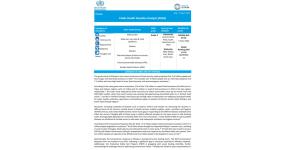Public Health Situation Analysis (PHSA)
The government of Ethiopia’s most recent assessment of food security needs projected that 15.8 million people will face hunger and need food assistance in 2024. This includes over 4 million people who are internally displaced and 7.2 million who have high levels of acute food insecurity and need emergency assistance.
According to the same government assessment, 51% of the 15.8 million in need of food assistance (8 million) are in Tigray and Amhara regions; with 4.5 million and 3.5 million in need of food assistance in 2024 in the two regions respectively.
The areas worst impacted by food insecurity are where communities have yet to recover from the 2020-2022 conflict, where the recent harvest was severely disrupted leaving households with no, or limited, food stocks.
Just like in northern Ethiopia, food insecurity and high rates of malnutrition are adding to protracted needs for water, health, protection, agriculture, and livelihood support in pockets of Oromia, Somali, South Ethiopia, and South West Ethiopia regions.
Moreover, increasing outbreaks of diseases such as malaria, cholera and measles are worsening the situation in different parts of the country. Limited access to health services, medical supplies, water, sanitation and hygiene (WASH) services, and trained health workers remain to be gaps in responding to the different disease outbreaks that affect the country. Roughly 60% of those living in cholera-affected woredas do not have access to safe drinking water, leaving people dependent on untreated water from rivers and ponds. A total of 60% to 80% of communicable diseases are attributed to limited access to safe water and inadequate sanitation and hygiene services.
According to the Humanitarian Response Plan for 2024, 21.4 million people need humanitarian assistance with 15.5 million people targeted for assistance. The El-Nino driven drought has impacted Ethiopia’s summer rains, resulting in severe water shortages, dried pastures and reduced harvests in many areas. A Flood Alert was issued in January 2024 by the Federal Government calling for preparedness and early response for the March-May rainy season. Over two million people are expected to be affected and one million people to be displaced in areas at risk.
Operationally, the humanitarian response in Ethiopia is hampered by low funding levels. The 2023 Humanitarian Response Plan was funded at just 34%, indicating a significant gap in resources required for effective response.
Additionally, the Productive Safety Net Program (PSNP) is grappling with acute funding shortfalls, further exacerbating the challenges faced in addressing humanitarian needs.
Notably the Health Clusters requirements for 2023 were only 24% funded, while WFP were only able to assist with 60% of the standard monthly entitlement in February 2024 due to a lack of funds.
According to the 2024 Humanitarian Needs Overview, the current multifaceted humanitarian crises are unfolding amidst a backdrop of severely weakened and overwhelmed national disaster and social protection response capacity. Since 2020, access to basic social services across Ethiopia has been in decline, attributed to a combination of natural and man-made crises. The second most populous country in Africa, Ethiopia’s 123 million people are affected by a multitude of complex issues. Conflict, internal displacement, socio-economic hardships, persistently limited access to safe water and sanitation, collapse of public services and natural hazards, including disease outbreaks, recurrent floods, locust outbreaks, loss of livestock and consecutive droughts, have increased the humanitarian needs in Ethiopia in 2024.
Technical contacts
Dr ABOK Patrick
EPR Team Lead
abokp [at] who.int (abokp[at]who[dot]int)
Dr. Abiy Girmay Haddis
Surveillance and Early Warning Lead
girmaya [at] who.int (girmaya[at]who[dot]int)
